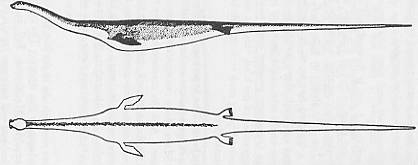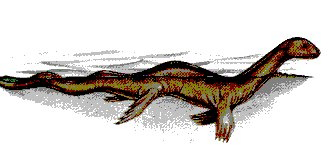
September 26, 2008

Before there was Bernard Heuvelmans’ long-necked Megalotaria longicollis, or my and Patrick Huyghe’s ideas, C. A. Oudemans proposed in 1892, in his masterwork The Great Sea Serpent, the species Megophias megophias, an immense long-necked, long-tailed pinniped. Oudemans’s reconstruction of Megophias is above. (Oudemans also extended this long-necked pinniped theory to what he felt were living in Loch Ness, in his next book – a small pamphlet, actually.)

Images of Sea Serpents appeared often, during the 1700s and 1800s, to reinforce the learned thoughts on this cryptid.



Now comes a remarkable discovery.

With congratulations, I applaud Darren Naish, who brings to our attention that…
…a Long-necked seal was described in the literature long prior to the work of Heuvelmans or even Oudemans. Reporting the observations of a Dr Grew on the Long-necked seal observed ‘in diverse countries’, James Parsons (1751) included an illustration [shown above] and description of this pinniped. He described how it was ‘[M]uch slenderer than either of the former [two other pinnipeds were described earlier in the manuscript]; but that, wherein he principally differs, is the length of his neck; for from his nose-end to his fore-feet, and from thence to his tail, are the same measure; as also in that, instead of his fore-feet, he hath rather fins; not having any claws thereon, as have the other kinds. The head and neck of this species are exactly like those of an otter. One of those, which is also now in our musaeum [sic], taken notice of by the same author, has an head shaped like that of a tortoise; less in proportion than that of every other species, with a narrowness of stricture round the neck: the fore-feet of these are five-finger’d, with nails, like the common seal. Their size, as to the utmost growth of an adult, is also very different. That before described, was 7 feet and an half in length; and, being very young, had scarce any teeth at all’ (Parsons 1751, p. 111).
Quite how a pinniped said at first to have a very long neck is then said to have a head and neck ‘exactly like those of an otter’ I’m not sure, and of course it’s not possible to determine whether this ‘long-necked seal’ has anything to do with Heuvelmans’s hypothetical animal of the same name. It’s tempting to assume that it was a confused description of a sea lion but, given that Parsons described a specimen 2.3 m long as a juvenile, it still sounds like an interesting animal that we’d like to know more about. To confuse things further, Parsons also mentioned a specimen which ‘is but 3 feet long, is very thick in proportion, and has a well-grown set of teeth’ (Parsons 1751, p. 112)….
The tantalising possibility remains that the larger specimen would have been significant in zoological terms, but given that we lack data on the provenance and fate of the specimens that were described by Parsons, any further comments would be entirely speculative. James Parsons, 1705-1770, was a British physician who studied medicine in Paris and later worked under James Douglas in London. As yet I haven’t done any research on the specimens he studied or wrote about, but this obviously should be done. What happened to his long-necked seal, and what was it?
Original source cited by Naish: Parsons, J. 1751. A dissertation upon the Class of the Phocae Marinae. Philosophical Transactions 47, 109-122.

Read all of Naish’s blog posting on this here.

Please note, while Darren is to be highlighted for his article, he also writes those who showed him the way: “I first heard of the article from Ben Speers-Roesch back when we were on the editorial board of the now defunct The Cryptozoology Review, and Ben in turn had heard about it from Scott Mardis.”
(Throughout this page, I have sprinkled various old wood carvings and other illustrations that may show alignments to or variations on Parsons’ long-necked pinniped.)
About Loren Coleman
Loren Coleman is one of the world’s leading cryptozoologists, some say “the” leading living cryptozoologist. Certainly, he is acknowledged as the current living American researcher and writer who has most popularized cryptozoology in the late 20th and early 21st centuries.
Starting his fieldwork and investigations in 1960, after traveling and trekking extensively in pursuit of cryptozoological mysteries, Coleman began writing to share his experiences in 1969. An honorary member of Ivan T. Sanderson’s Society for the Investigation of the Unexplained in the 1970s, Coleman has been bestowed with similar honorary memberships of the North Idaho College Cryptozoology Club in 1983, and in subsequent years, that of the British Columbia Scientific Cryptozoology Club, CryptoSafari International, and other international organizations. He was also a Life Member and Benefactor of the International Society of Cryptozoology (now-defunct).
Loren Coleman’s daily blog, as a member of the Cryptomundo Team, served as an ongoing avenue of communication for the ever-growing body of cryptozoo news from 2005 through 2013. He returned as an infrequent contributor beginning Halloween week of 2015.
Coleman is the founder in 2003, and current director of the International Cryptozoology Museum in Portland, Maine.
Filed under Cryptotourism, CryptoZoo News, Cryptozoologists, Cryptozoology, Lake Monsters, Loch Ness Monster, Sea Serpents